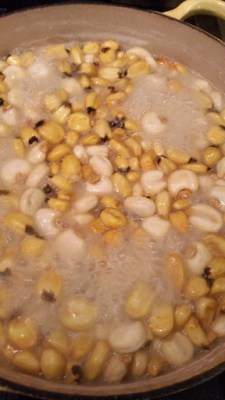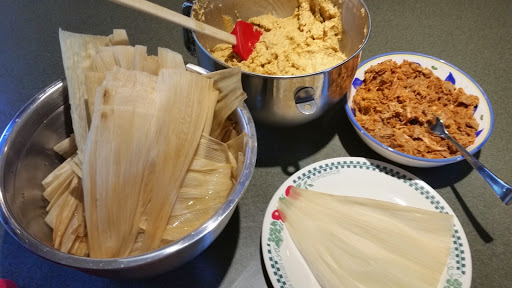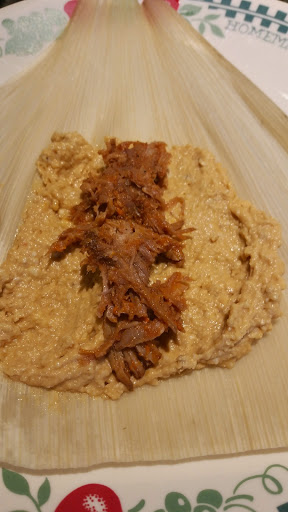 |
I’ve been working on perfecting my tamale masa. My first tamales were made with Maseca instant masa, but they lacked texture and homemade goodness. Light, fluffy, flavorful masa is the key to a great tamale. I think I’ve got it! Once you’ve got the masa mastered, any filling will make a good tamale.
I have been experimenting with different corns for masa. I’ve been using 2-3 types. Goya white or yellow hominy (very large kernels) and Peruvian dent corn (sort of like field corn, but grown for use in Andean stews). The place where I shop has almost an entire aisle of different corns. I’m also going to grow some Oaxacan green corn in my garden this year.
 |
| Two kinds of corn, washed and ready |
The process of turning corn into masa is called “Nixtamalizing.” A typical batch for 40 tamales starts with 4 cups of corn kernels. Wash under a stream of cool tap water. Pick out any kernels that look bad (discolored, bug chewed, etc.). Add 2 quarts of water to a pot and then add 2T of slaked lime (Cal, as it is known in Latino groceries). Bring to a boil, add the corn and boil for 15 minutes. Let the covered pot site for 2-3 hours off heat. The smell of the corn at this point will make your mouth water.
 |
| Slaked lime |
 |
| Boiling the corn with lime |
Transfer the corn to a large colander and rinse with lots of cool water. Squeeze handfuls of kernels to pop off the membrane covering each one. When you think it is clean, put it back in the pot and cover with water. Slosh it around and if the water is clear, you are done. If not, then back in the colander and more cleaning. It usually takes me 3-4 times until the water in the pot is clear and the worn is very clean of membranes. Drain the corn in the colander.
 |
| Washed corn |
Prepare a meat grinder with a fine plate (1/8 inch). Run the drained corn through the grinder. Run it all through again. The first time, the corn will be coarse and dry. The second time it is moist and sticky. Add any corn that remained inside the body of the grinder, as it will still be coarse and will add more texture to the finished masa.
 |
| First grind: dry |
 |
| Second grind: Moist |
Next, put ½ cup of lard (good lard, not the white supermarket kind – look for lard in a Latino store, gold in color) into a stand mixer bowl. Add 1 tsp Baking Powder. Using the blade attachment, whip the lard until it is fluffy. With the mixer running on speed 1 or 2, add handfuls of the ground corn. When all of the corn is added, add in rich pork, chicken or beef stock (you can use water, but it will not be as good) until the consistency is like thick pancake batter. It usually takes about a cup. I add a couple spoonfuls of chili paste made from toasted, soaked, pureed and strained New Mexican chilies. Add 1-2 tsp of sea salt. Taste the masa and adjust as needed. Scoop into a container and refrigerate overnight.
 |
| Mixing tamale masa |
The next day when you are ready to make tamales (the masa will hold OK in the fridge for a few days), remove the masa from the fridge and put it back in the mixer bowl. Mix in another ½ to 1 cup of stock to really make the batter light. Taste and salt if needed.
Get your tamale wrappers ready. I normally use corn husks that can be bought by the bale in Latino groceries. Pick out 40-50 nice big ones from your bag. Toss in any small ones too as you will need them. Wash with water and then place in a large pot. Cover with water and bring to a boil. Let soak for an hour. Remove the husks from the pot and into a large bowl for your work station.
For today’s tamales, I made a pork filling. Cubes of pork butt cooked with pork stock, chile paste (same as above), Mexican oregano, garlic, cumin, onion, salt and pepper. Cook until it can be shredded with two forks, about 2 hours at a simmer.
Assemble the tamale station. Corn husk wrappers, masa, and filling. I scoop about 4-5 Tablespoons of masa in the middle of the wide end of a husk. Don’t go all the way to the edge. Make about a 3-4 inch circle. Down the middle, place about 1-2T of filling. Bring the two sides of the wrapper together so the masa goes around the filling. Lay it down flat with the edges away from you. Roll the whole thing toward the open edges. Not too tight or it will come out the top. Fold the tip up to close the bottom. Some folks tie each one, but I do not.
As the tamales are rolled stand them up on a large pot set up with a steamer covered with left over husks. If you do not have enough tamales to fill the pot, then fill the open space with loosely wadded foil. If you have too many tamales, then make another layer by placing more husks on top of the first layer. Otherwise, start a new pot.
Steam for an hour covered. Serve the tamales warm. Top with some tomatillo salsa and a bit of grated Cotija cheese.
Tomatillo Salsa
8-10 large tomatillos washed and halved
5 cloves garlic
Dash grapeseed oil
25 Chile di Arbol broken in half and seeds shaken out
1/2 tsp sea salt
Roast the tomatillos and garlic in a dry cast iron skillet over medium heat until they have black blisters on all sides. The tomatillos should turn a dull green, but not turn mushy. Remove the tomatillos and garlic to a blender. Add the oil to the skillet and add in the chilies. Toast until they give off a nutty aroma. Do not burn them. Add to blender. Puree and pour into storage container.
Once you get the knack of making the masa, a fun idea is to host a tamale party. You provide the masa and the wrappers, and everyone brings a different filling – chicken and green chiles, mushrooms and tomatoes, habanero lime shrimp, and garlicky kale with toasted pumpkin seeds make great fillings. Leftover chili or taco meat work, too.








4 thoughts